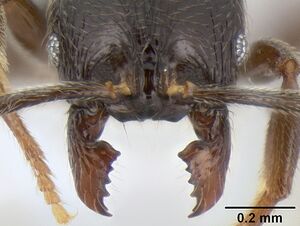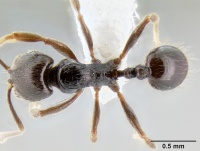Stenamma sandinista
| Stenamma sandinista | |
|---|---|

| |
| Scientific classification | |
| Kingdom: | Animalia |
| Phylum: | Arthropoda |
| Class: | Insecta |
| Order: | Hymenoptera |
| Family: | Formicidae |
| Subfamily: | Myrmicinae |
| Tribe: | Stenammini |
| Genus: | Stenamma |
| Species: | S. sandinista |
| Binomial name | |
| Stenamma sandinista Branstetter, 2013 | |
Stenamma sandinista is a specialist of montane wet forest habitats (e.g. cloud forest, dwarf forest, mesic forest) and is known from approximately 900–1600 m elevation. Nearly all collections are from sifted leaf litter taken from the forest floor. Only once in dwarf cloud forest habitat have I found a nest fragment. It was in leaf litter and was located by randomly scraping back the top layer of leaves while collecting a Winkler sample. The nest had tens of workers and brood.
Identification
Branstetter (2013) - Integument mostly dark brown to brown; small-sized species (see HL, ML, PrW below); basal margin of mandible sinuous, with a distinct basal notch and accompanying small inner tooth; anterior clypeal margin forming 4 small teeth (inner teeth only visible from an anterodorsal angle and with mandibles open); gastral setae noticeably bilayered, with a layer of long suberect setae, and a sparse layer of short decumbent setae; face mostly covered with fine longitudinal carinulae and rugulae, posterior margin and posterolateral surfaces smooth and shiny; promesonotal dorsum with fine longitudinal and arcuate carinulae, that usually wrap around a central patch of smooth cuticle, remainder of mesosoma with light rugulae and punctae; eye of moderate size (EL 0.10–0.14, REL 15–20), with 4–5 ommatidia at greatest diameter; propodeal spines reduced to very small tubercles (PSL 0.07–0.09, PSI 1.1–1.3); frontal lobes of moderate width (FLD 0.13–0.16, FLI 20–24), not obscuring torular lobes in full-face view.
Stenamma sandinista can be separated from similar forms (Stenamma nanozoi, Stenamma nonotch, Stenamma saenzae, Stenamma schmidti) by its eye size, mandibular structure, facial sculpture, and gastral pilosity. Geography is also useful, as it is present at only a few high-elevation sites within Nicaragua.
Keys including this Species
Distribution
Latitudinal Distribution Pattern
Latitudinal Range: 13.12233° to 12.97389°.
| North Temperate |
North Subtropical |
Tropical | South Subtropical |
South Temperate |
- Source: AntMaps
Distribution based on Regional Taxon Lists
Neotropical Region: Nicaragua (type locality).
Distribution based on AntMaps
Distribution based on AntWeb specimens
Check data from AntWeb
Countries Occupied
| Number of countries occupied by this species based on AntWiki Regional Taxon Lists. In general, fewer countries occupied indicates a narrower range, while more countries indicates a more widespread species. |

|
Estimated Abundance
| Relative abundance based on number of AntMaps records per species (this species within the purple bar). Fewer records (to the left) indicates a less abundant/encountered species while more records (to the right) indicates more abundant/encountered species. |

|
Biology
Castes
Worker
Images from AntWeb
   
| |
| Holotype Stenamma sandinista. Worker. Specimen code casent0622578. Photographer Michael Branstetter, uploaded by Curator Michael Branstetter. | Owned by USNM. |
Queen
Images from AntWeb
   
| |
| Paratype Stenamma sandinista. Queen (alate/dealate). Specimen code casent0622583. Photographer Michael Branstetter, uploaded by Curator Michael Branstetter. | Owned by USNM. |
Male
Images from AntWeb
    
| |
| Male (alate). Specimen code casent0622731. Photographer Michael Branstetter, uploaded by Curator Michael Branstetter. | Owned by MGBPC. |
Nomenclature
The following information is derived from Barry Bolton's Online Catalogue of the Ants of the World.
- sandinista. Stenamma sandinista Branstetter, 2013: 232, figs. 150, 151 (w.q.m.) NICARAGUA.
- Type-material: holotype worker, 15 paratype workers, 4 paratype queens.
- Type-locality: holotype Nicaragua: Jinotega, Reserva Natural Datanlí El Diablo, 13.10852°N, 85.86780°W±10 m., 1440 m., 18.v.2011, LLAMA Wa-D-04-1-01; paratypes: 2 workers, 1 queen with same data, 13 workers, 3 queens with same data but 13.10859°N, 85.86724°W±10m., LLAMA Wa-D-04-1-03.
- Type-depositories: USNM (holotype); CASC, CFSS, EAPZ, FMNH, ICNB, INBC, JTLC, LACM, MCZC, MGBC, MZSP, UCDC, UNAM, USNM, UVGC (paratypes).
- Distribution: Nicaragua.
Unless otherwise noted the text for the remainder of this section is reported from the publication that includes the original description.
Description
Worker
(10 measured) HL 0.62–0.73 (0.62), HW 0.56–0.70 (0.56), FLD 0.13–0.16 (0.13), PCW 0.03–0.04 (0.03), SL 0.52–0.61 (0.52), EL 0.10–0.14 (0.11), ACL 0.51–0.58 (0.51), ML 0.77–0.89 (0.77), PrW 0.07–0.09 (0.08), PSL 0.07–0.09 (008), SDL 0.06–0.08 (0.07), PL 0.27–0.34 (0.28), PH 0.17–0.20 (0.17), PW 0.13–0.17 (0.13), PPL 0.15–0.19 (0.16), PPH 0.15–0.18 (0.15), PPW 0.17–0.21 (0.17), MFL 0.55–0.65 (0.55), MTL 0.43–0.52 (0.43), CI 90–96 (90), SI 87–94 (94), REL 15–20 (19), FLI 20–24 (24), PSI 1.1–1.3 (1.2), MFI 98–111 (102), ACI1 65–67 (67), ACI2 91–97 (96).
Small-sized species; general body color dark brown to brown, with appendages lighter, brown to yellow-brown toward extremities; setae golden brown; mandible usually with 6 distinct teeth, basal tooth well-defined; basal margin of mandible sinuous, with a distinct basal notch and accompanying small inner tooth; mandible mostly smooth, except for scattered piligerous punctae, and several striae around the base and lateral surface; anterior clypeal margin in anterodorsal view forming 4 small teeth (only outer teeth visible in full-face view); median clypeal lobe with faint longitudinal carinulae that diverge toward anterior margin, apex of lobe with a short and long transverse carinula, area in between transverse carinula and anterior clypeal margin forming a distinct cavity for mandibles, remainder of clypeal surface mostly smooth; posterior extension of clypeus between antennal insertions of moderate width (PCW 0.03–0.04), with sides subparallel; frontal lobes of moderate width (FLD 0.13–0.16, FLI 20–24), not covering torular lobes in full-face view; head subcircular to oval-shaped (CI 90–96), with posterior margin distinctly depressed; eye of moderate size (EL 0.10–0.14, REL 15–20), with 4–5 ommatidia at greatest diameter; face mostly covered with many short to long longitudinal carinulae and rugulae, posterior margin and posterolateral surfaces smooth and shiny; scape of moderate length (SI 87–94), not quite reaching posterior margin when laid back; scape surface mostly shiny, with some faint striations, and scattered piligerous punctae; flagellum with a distinct 4-segmented antennal club; promesonotal dorsum with longitudinal and arcuate carinulae, that usually wrap around a central patch of smooth cuticle, but sometimes entire dorsum sparsely carinulate, side of pronotum mostly smooth, mesopleuron and side of propodeum with variably developed punctae and rugulae, sometimes mesopleuron mostly smooth, propodeal dorsum and declivity with some transverse carinulae; promesonotum in profile low-domed, and roughly symmetrical; metanotal groove in profile of moderate width and depth, often with a small central welt (metanotum); propodeal spines reduced to small tubercles (PSL 0.07–0.09, PSI 1.1–1.3); dorsal edge of propodeal lobe in profile markedly elongate; petiole in profile appearing of moderate to long length (PL/HW 0.45–0.51); petiolar node of moderate height (PH/PL 0.58–0.65), slightly asymmetrical, with anterior face longer and more sloping than posterior face, dorsum of node gently rounded, always pointing distinctly posteriad; post-petiole in profile appearing similar in size to petiolar node (PPH/PH 0.83–0.94), subspherical, with anterior face only slightly longer than posterior face; petiole and postpetiole mostly lightly punctate, with some rugulae around nodes, anterior faces of nodes and dorsum of peduncle mostly smooth; gaster mostly smooth and shiny, with scattered piligerous punctae; face pilosity short, with a layer of suberect setae, and a denser layer of decumbent setae; setae on mesosoma and gaster mostly long and suberect, gaster with a sparse layer of decumbent setae; scape setae uniformly subdecumbent; setae on legs mostly subdecumbent, with a few suberect setae on femoral venters and coxae.
Queen
(5 measured) HL 0.67–0.70 (0.69), HW 0.62–0.65 (0.63), FLD 0.15–0.16 (0.15), PCW 0.03–0.05 (0.04), SL 0.58–0.59 (0.59), EL 0.17–0.18 (0.18), ACL 0.54–0.56 (0.54), ML 0.96–0.99 (0.99), PrW 0.55–0.56, PSL 0.10– 0.12, SDL 0.07–0.09, PL 0.35–0.37 (0.36), PH 0.20 PW 0.16–0.18 (0.18), PPL 0.18–0.19 (0.19), PPH 0.19–0.21 (0.21), PPW 0.21–0.22 (0.22), MFL 0.62–0.65 (0.65), MTL 0.50–0.52 (0.51), CI 92–95 (92), SI 90–93 (93), REL 27–28 (28), FLI 24–25 (24), PSI 1.2–1.4 (1.3), MFI 98–104 (98), ACI1 63–68 (65), ACI2 92–97 (92).
Same as worker except for standard queen modifications and as follows: pronotum with transverse carinulae/rugulae; mesoscutum mostly with longitudinal carinulae/rugulae, sometimes humeral area mostly smooth, with only piligerous punctae; scutellum smooth in center, longitudinal rugulae elsewhere; propodeum with transverse carinulae that wrap around surface; mesopleuron mostly smooth; pilosity on gastral tergites clearly bilayered with a dense layer of short, subdecumbent pubescence, and a relatively sparse layer of longer suberect setae (not as long as in worker); wing venation as in Figure 151D.
Type Material
Holotype worker. NICARAGUA, Jinotega: Reserva Natural Datanlí El Diablo, 13.10852°N, 85.86780°W ±10m, 1440m, 18 May 2011, cloud forest, ex sifted leaf litter (LLAMA, collection Wa-D-04-1-01) USNM, specimen CASENT0622578. Paratypes: same data as holotype [1dq, 1w, CASC, CASENT0622575, CASENT0622576, 1w, EAPZ, CASENT0622577; same data but 13.10859°N, 85.86724°W ±10m, 1440m, 18 May 2011 (LLAMA, Wa-D-04-103) 1w, ECOSCE, CASENT0623486, 1w, FMNH, CASENT0623487, 1w, ICN, CASENT0623488, 1w, INBC, CASENT0623489, 1w, JTLC, CASENT0623490, 1w, LACM, CASENT0623491, 1dq, 1w, MGBPC, CASENT0623498, CASENT0623492, 1dq, 1w, MCZ, CASENT0623493, CASENT0623494, 1w, MZSP, CASENT0623495, 1w, UCDC, CASENT0623496, 1w, UNAM, CASENT0623497, 1dq, 1w, USNM, CASENT0622583, CASENT0623499, 1w, UVGC, CASENT0623500.
References
- Branstetter, M. G. 2012. Origin and diversification of the cryptic ant genus Stenamma Westwood (Hymenoptera: Formicidae), inferred from multilocus molecular data, biogeography and natural history. Systematic Entomology 37:478-496. doi:10.1111/j.1365-3113.2012.00624.x
- Branstetter, M.G. 2013. Revision of the Middle American clade of the ant genus Stenamma Westwood (Hymenoptera, Formicidae, Myrmicinae). ZooKeys 295, 1–277. doi:10.3897/zookeys.295.4905
References based on Global Ant Biodiversity Informatics
- Branstetter M.G. 2013. Revision of the Middle American clade of the ant genus Stenamma Westwood (Hymenoptera, Formicidae, Myrmicinae). ZooKeys 295: 1277
- Longino J. T. L., and M. G. Branstetter. 2018. The truncated bell: an enigmatic but pervasive elevational diversity pattern in Middle American ants. Ecography 41: 1-12.


